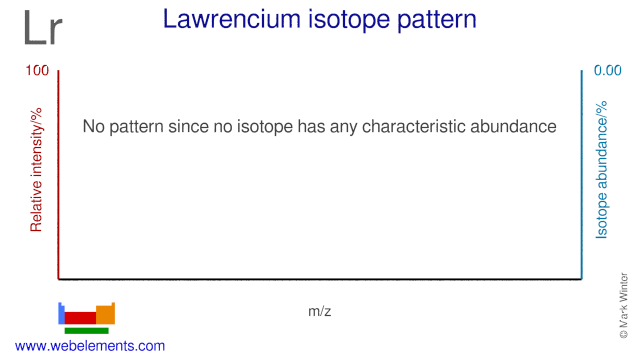Lawrencium - 103Lr: the essentials
- Name: lawrencium
- Symbol: Lr
- Atomic number: 103
- Relative atomic mass (Ar): [ 262 ] (longest lived isotope)
- Standard state: presumably a solid at 298 K
- Appearance: unknown, but probably metallic and silvery white or grey in appearance
- Classification: Metallic
- Group in periodic table: 3
- Group name: (none)
- Period in periodic table: 7
- Block in periodic table: d
- Shell structure: 2.8.18.32.32.9.2
- CAS Registry: 22537-19-5
Lawrencium atoms have 103 electrons and the shell structure is 2.8.18.32.32.9.2. The ground state electronic configuration of neutral lawrencium is [Rn].5f14.6d1.7s2 (a guess based upon that of lutetium) and the term symbol of lawrencium is 2P1/2 (tentative).
Lawrencium: description
Lawrencium is a synthetic "rare earth metal" which does not occur in the environment.
Lawrencium: physical properties
Density of solid: (no data) kg m-3
Molar volume: (no data) cm3
Thermal conductivity: 10 (estimate) W m‑1 K‑1
Lawrencium: heat properties
Melting point: about 1900 [1627 °C (2961 °F)] K
Boiling point: (no data) K
Enthalpy of fusion: 20.5 kJ mol-1
Lawrencium: atom sizes
Atomic radius (empirical): (no data) pm
Molecular single bond covalent radius: 161 (coordination number 3) ppm
van der Waals radius: (no data) ppm
Lawrencium: electronegativities
Pauling electronegativity: (no data) (Pauling units)
Allred Rochow electronegativity: (no data) (Pauling units)
Mulliken-Jaffe electronegativity: (no data)
Lawrencium: orbital properties
First ionisation energy: 479 kJ mol‑1
Second ionisation energy: 1400 kJ mol‑1
Third ionisation energy: 2100 kJ mol‑1
Lawrencium: abundances
Universe: (no data) ppb by weight
Crustal rocks: (no data) ppb by weight
Human: (no data) ppb by weight
Lawrencium: crystal structure

Lawrencium: biological data
Human abundance by weight: (no data) ppb by weight
Lawrencium has no biological role.
Lawrencium: uses
Lawrencium: reactions
Reactions of lawrencium as the element with air, water, halogens, acids, and bases where known.
Lawrencium: binary compounds
Binary compounds with halogens (known as halides), oxygen (known as oxides), hydrogen (known as hydrides), and other compounds of lawrencium where known.
Lawrencium: compound properties
Bond strengths; lattice energies of lawrencium halides, hydrides, oxides (where known); and reduction potentials where known.
Lawrencium: history
Lawrencium was discovered by Albert Ghiorso, Torbjorn Sikkeland, Almon Larsh, Robert M. Latimer in 1961 at United States. Origin of name: temporary IUPAC nomenclature. The origin of the Amercian Chemical Society preferred name is Ernest O. "Lawrence", inventor of the cyclotron.Lawrencium: isotopes

Lawrencium: isolation
Isolation: coming soon!
